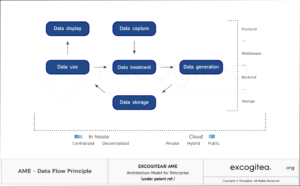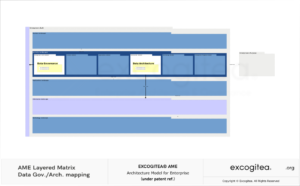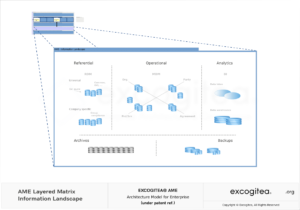EXCOGITEA® AME – Architecture Model for Enterprise
Enterprise Architecture address the heterogeneity and the dynamics of the Enterprise.
Amongst the constituents of the Enterprise, there’s that thing called Data/Information.
Any initiative concerning or involving data normally invites to consider Data Governance, which defines the rules for Data Management.
The full reference book DAMA-DMBOK (from DAMA International) provides all the guidance and best practice for the matter.
The book (2nd edition) contains 17 chapters over 600 pages.
Among them, there’s that one dealing with Data Architecture and its integration into Enterprise Architecture. …
EXCOGITEA® & Data
Usually, the first feeling is that “data are everywhere”, or should we say “data are used everywhere”.
The reaction can be to put names on it, to define semantics. This, from a claimed “ontology” initiative.
This can be useful … and endless.
Here’s a thing:
A data can be seen through Business viewpoint, IT viewpoint, Legal viewpoint, …
It depends on the stakeholders, data owners, data providers, …
EXCOGITEA® considers Data as such, and makes the distinction with its multiple “uses”.
That would be the point of an ontology approach.
Acknowledging this, EXCOGITEA® conceptualized the mechanics of dealing with data.
That concept is an integrated part of the EXCOGITEA® Model. It allows an organization to address and manage any data through its scheme.
EXCOGITEA® AME – Architecture Model for Enterprise
AME – Data Flow Principle

The diagram shows what the journeys of a data can be.
Moreover, the diagram provides awareness regarding metadata management.
Metadata applies from the early stage of data. It is a part of the data buffer and it is updated with each data manipulation.
The metadata is inseparable from the data. It accompanies it throughout its journey, including its storage where it constitutes its description, and this throughout its lifespan.
AME Layered Matrix – Data/Information

The AME model identifies the activity of Data Governance and maps it according to its impacts.
Whether a “Centralized”, a “Replicated” or a “Federated” Governance (cf. DMBOK), the overall Enterprise scheme is impacted.
Data must be sorted/organized according to their nature, not their uses.
The AME model identifies a dedicated space for Data, and integrates it into the overall Enterprise scheme as an Enterprise constituent: the Information Landscape.
This dedicated space is shaped by the identified activity of Data Architecture.
AME Layered Matrix – Information Landscape

The AME Information Landscape is the space dedicated to organize Data.
It is a logical view that allows to address the overall coherence of Data.
Being decoupled from a technical view, it permits to manage digital and non-digital information.
AME also shapes that landscape and defines several sub-spaces themselves dedicated to Referential Data, Operational Data, Analytics Data, …
Rem: It provides a schema which supports several other chapters of DAMA book.
Proper data organization also means clear identification and characterization of data.
From data pools to the metadata canvas, the different descriptions will determine the definitions of the Data Catalogs.
Metadata canvas is firstly generic because it relates to the nature of data.
Then, it contains all the indicators defined by Data Governance and necessary for Data Management. (source, trust level, confidentiality level, …)
Finally, it contains all the indicators specific to the use of the associated data.
Properly identifying and organizing Data leads to master their uses anywhere in the Enterprise scheme.
“FAIR” principles (Findable, Accessible, Interoperable, Reusable)
It is a part of “integrating the constraints” aspect of Architecture practice.
Architecture integrates these principles in its design work and provides the schema to support FAIR and make it tangible.
Data Architecture fits into Enterprise Architecture.
Not only that Enterprise Architecture permits Data Architecture to be aligned with the other constituents of the Enterprise.
As it provides the schema to define, model and organize Enterprise activities, workforces assignments, enablers, …
- Enterprise Architecture permits to identify and define roles and responsibilities. (Data officers, Data Governance Leader, Data owners, Data stewards, …)
- Enterprise Architecture permits to define Data distribution scheme and identify Data uses within activities. (Data Fabric, Data Mesh, Data Products, …)
- Enterprise Architecture provides the overall scheme to address Data Quality, Data Security, Data Confidentiality, …
- …
While Data Governance will lead to consider Architecture, reversely, Enterprise Architecture leads to address Data and its Governance.
Enterprise Architecture is a contributor of Data Governance, if not a trigger.
